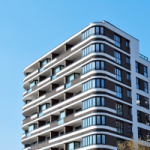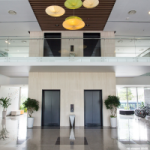Which has more depreciation? Houses, apartments or commercial properties?
It’s something we get asked often. You might, too. Our answer is always, ‘It depends’.
We follow that up with pointing out that the depreciation deduction should not be the main factor in making a purchase decision, though it is a nice deduction to take off the table every year with no need to outlay anything.
That’s something not all clients understand, i.e. depreciation is just sitting there waiting to be claimed. They just need someone to work out how much they can claim. And that’s what we have been doing for over 20 years.
Backing up a few steps, depreciation is driven by what a property cost to build, and not what it cost to buy. Houses in capital cities especially often cost more than apartments to buy, but it’s usually the value of the land driving that cost. And land, of course, does not come into depreciation. An office in a large strata building will have similar depreciation to an apartment. While a small factory unit will have less. And farms are a whole other ball game. We covered commercial properties at length in a ‘Something You Didn’t Know About Depreciation‘ last year.
Key Points
- Depreciation is driven by what a property cost to build, and not what it cost to buy.
- Depreciation for houses depends on the age of the house, the size, construction type, and the quality. This gives us an estimated build cost at the time of construction that our depreciation schedules are based on.
- Depreciation for apartments has an additional layer: the common areas of the building. Clients own a part of them and can therefore claim depreciation on the structural works and in some cases the associated Assets.
- Commercial properties can vary wildly in size and complexity and in depreciation returns. But we do them all.
- So which property has more depreciation? Houses, apartments or commercial properties? The short answer is, it depends!
 Depreciation returns on houses
Depreciation returns on houses
Let’s look at houses first of all.
It’s arguably easier to work out the construction cost of a house than an apartment. Sure, there are some very fancy houses we do, but many houses that are rented out are fairly modest.
First up we need to know the age of the house. Did you know there is still depreciation available in houses where construction started after September 1987? Yep, older houses still have something to claim, which surprises many clients – and accountants.
We have a handy table that shows you the depreciation claimable on older properties.
And we have written about it in previous ‘Something You Didn’t Know About Depreciation‘.
(There are also renovations to older properties that may have been done by previous owners. Renovations can have good depreciation regardless of the age of the property. You can read more about this here.)
Having established the age of the house, we then look at the size, construction type, and the quality to arrive at an estimated build cost at the time of construction.
Often we can do modest older houses without an inspection to save your clients money, but we are always happy to inspect. Generally with these jobs, there is no depreciation available in the second hand Assets e.g. appliances, floor coverings etc, but we still value and note them for you in case it is of use. We guarantee to find at least 2 x our fee in the first full year on modest unrenovated houses built after September 1987. If we don’t think a job is worth doing, we’ll tell your client.
Brand new houses rented out immediately have more depreciation because the Assets can also be depreciated. We have a guarantee for brand new houses that we will find more than 10 x our fee in just the first full year of depreciation. Often we don’t need to inspect these either, especially if the client has a building contract that has the total price, plans and specifications. But again, we are always happy to inspect if a client prefers.
Then there are the complicated houses. A difficult site or interesting construction methods cost more. We routinely inspect houses where the construction cost is well over $1 million. Pools can add significant costs, as can second kitchens and basement areas. We’ve even been into houses with garages fitted with turntables and car lifts.
We recently finished a Depreciation Schedule on a complicated, brand new house where the depreciation in the first full year was a shade over $90,000.
 Depreciation returns on apartments
Depreciation returns on apartments
Now let’s look at apartments.
Why are they sometimes more difficult?
Common areas.
Pools, gyms, lobbies, underground parking, rooftop decks – clients own a part of them and can therefore claim depreciation on the structural works and in some cases the associated Assets.
Apartment complexes need a visit, at least for the first Depreciation Schedule in the building. What we mean by that is that after one has been done and common areas surveyed, it is often possible to do subsequent jobs in that building without a visit.
For a brand new apartment in a large complex rented out straightaway, the depreciation is boosted by the common area Assets e.g. elevators, ventilation, furniture and equipment. Being able to include the Assets in a job will boost the depreciation return by 40%. It’s not unusual for a brand new apartment in a nice building to have around $15,000 in depreciation in the first full year.
You can find a table here with a rough guide for depreciation on properties rented out brand new.
Even second hand apartments in large complexes can have good depreciation in the Capital Works.
Of course, apartments in smaller complexes with few common facilities can have less depreciation than houses simply because the build cost for a modest apartment in a small complex can often be less than a comparable house.
So it all largely gets back to the cost to build the dwelling, as opposed to the cost to buy it. This can perhaps best be demonstrated by pondering comparable apartments.
Let’s imagine a client buys a new two bedroom apartment on the first floor of a large and fancy new building on the coast. Immediately beneath their balcony is the entrance to the underground carpark with a roller door, a squeaky one, that opens all the time. Beside that entrance is the area where the garbage bins are kept. And it’s a coastal location, so there are plenty of fish scraps in those bins. And then across the shabby rear lane, the view is of a Maccas carpark – with a drive-through that operates 24 hours.
Now let’s imagine another client buys an identical apartment – same size and layout – in that building but theirs is on the 6th floor. Facing the ocean. They can sit on their balcony as the sun rises and watch the local tradies catching a wave before heading off to work – or not, if the waves are good. They can see whales cavorting further out. Maybe there is a sailing boat or two.
These clients would have paid very different amounts to buy their apartments, but the cost to build them would not have differed much. And should they rent them out, the depreciation would be similar, which is some consolation for the client with the first apartment.
 Depreciation returns on commercial properties
Depreciation returns on commercial properties
The depreciation on commercial properties can vary as much as the properties themselves do. And we have done them all. Everything from small standalone shops right up to large farms. Once we even did a prawn farm. And some years ago we had a run of chicken farms on the outskirts of Melbourne.
The eligibility dates and some rates can differ from residential property, but the cost to build the property is still the main driver of depreciation.
And often there are substantial common areas, just like apartments. Offices in strata buildings will have lobbies and underground parking and all the Assets associated with them: elevators, mechanical ventilation, floor coverings etc.
The per square metre cost to build an office is often similar to that of an apartment, but the air conditioning and technology included in a new office fitout can push the depreciation returns up significantly.
Modest factory units can also have extensive common areas. There are driveways and sometimes expansive hardstand areas for trucks to manoeuvre and park on – and the concrete in these areas will be more robust and therefore more expensive than that in a residential setting. Then there are fences, gates, security systems etc.
And of course the buildings themselves can vary in complexity. The preferred method of construction for factory units in groups is tilt up concrete. It can run to $1,800 – $1,900 per square metre – preferred partly because it is simple and fast and provides fire protection. Larger standalone factories these days tend to be constructed using portal frames and cladding which brings down the cost per square metre.
But one benefit commercial properties have over residential is that the second hand Assets (Plant and Equipment) can be claimed. You will recall in residential property, depreciation can no longer be claimed on second hand Assets. You can read more about this here.
So getting back to the question about which properties have more depreciation, as we wrote, ‘it depends’.
But rest assured we do them all.
If you have a client we can help with claiming depreciation on a commercial, or residential, property, use your booking link, or make an online enquiry.




